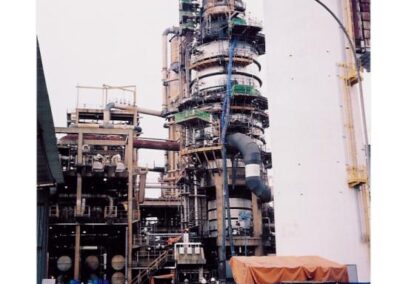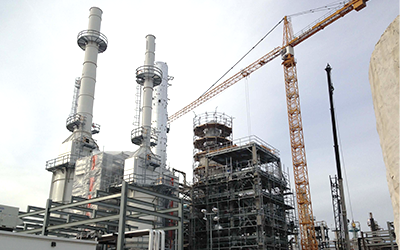Part 14
Foam Cleaning Methodology
Foam cleaning represents a unique application of a technological extension of conventional chemical cleaning methodology. It is extremely well suited to the cleaning of large volume equipment and structures which are unable to support the weight of conventional liquid solvents.
The same solvents used in common liquid-fill cleaning operations are again employed for foam cleaning. The major difference is the addition to the liquid solvent of a suitable foaming agent. The surfactant convers stability to the foam which is generated by mixing air with the common solvent.
Now, this sounds fairly simple on the surface, but there are many critical criteria to consider in making a foam cleaning application successful. When we use the term “solvent”, it is intended to convey a liquid that imparts dissolution capacity to a solute. The solvent can be either water-based or oil-soluble, neutral, acidic or alkaline pH. The target solute can be inorganic scale deposits or heavy organic debris such as condensed aromatics (asphaltenes).
Advantages of Foam Cleaning
Foamed solvents offer numerous advantages over conventional liquid solvents in terms of versatility, cleaning ability, economics and safety.
They are considered to be more versatile for two reasons. First, almost any acidic or alkaline cleaning solvent may be foamed. Secondly, the foam’s density makes it more suitable for chemically cleaning structures in which solvent-weight is a critical consideration. Unlike conventional liquid solvents, foamed solvents are capable of more completely filling vessels, pipes and even bowed tubing. In addition, foams display a more thorough scouring of metal surfaces. Finally, their ability to hold particles in suspension enables them to carry-off sloughed material readily. These three important factors contribute to their superior cleaning ability.
Higher solvent concentrations can be used more economically in foamed rather than liquid form. In some instances, economics dictates against the use of concentrated solvents for liquid-fill operations. However, in many of these same cases, the cleaning may be affected both efficiently and economically by foaming these same concentrated solvents.
Vapor Phase vs. Foam Cleaning Applications
In recent years, the industry has migrated to application of chemical products through the use of steam. This process involves using a steam flow as the carrier media for distributing chemical cleaning products throughout a fouled piece of equipment. While the technique is suitable for environments where adequate steam supply of sufficient steam flow and quality is available, there are many situations where the required steam conditions cannot be supplied or it is uneconomical to generate steam through portable boiler operations. Vapor phase steam application is the most common method for chemically cleaning process towers, columns and other such equipment.
In equipment requiring hazardous gas reduction, vapor phase application is less effective than a foam cleaning application of the same chemical additives employed for the hazardous gas removal. Condensation of steam into warm water in restricted areas of access, prohibits adequate access of the chemical additive until the equipment is uniformly hot and steam can actually carry the cleaning chemicals to all areas of concern. This same problem is less of a concern with foam-in application. The foam can penetrate into all areas of the equipment and is not dependent upon temperature, is not hampered by condensation and is not delayed in action. Additionally, foam provides abundant surface area through the creation of a foam bubble with a thin-film surface of active chemical. For chemical additives that actually have an active absorptive capacity and do not rely exclusively on steam pressure to physically force out hazardous vapor by steam displacement, the immense surface area created by thin-film foam can speed the process of vapor removal in significant sum.
This is not to dismiss the effectiveness of vapor phase chemical cleaning. Not all equipment is suitable for one or the other methodology. You should be aware that in many instances and with various equipment, a foam application of chemical cleaning products can provide you with exceptional results that rival and or exceed that of steam vapor phase techniques.
Equipment
Equipment used in foam cleaning consists of a solvent mixing tank, metering units and a foam generator. Any conventional tank can be used as the solvent mixing vessel. A foam generator consists of aerators and a separator tank. A drawing of a general foam generator is provided below.
Limitations of Foam Cleaning
The preferred foam-solvent ratio is approximately 20:1. Therefore, only 5% of the foam volume is actual solvent. At no one time, then, is there sufficient solvent present in the unit being cleaned to completely remove the contaminant. Consequently, it is necessary to promote a constant foam flow. A continuous stream of foam will bathe the interior surfaces of the unit being cleaned with solvent and dissolve and wash away the interfering contaminants. The actual flow rate must be sufficient to provide complete passage through the unit before the solvent becomes spent, while preventing uneconomical waste of unspent solvent.
Two important limitations of foamed cleaning exist. The first and most important limitation is the compatibility of the proposed solvent to the desired contaminant removal. This difficulty is easily circumvented by establishing solvent adequacy, in advance, with appropriate field and/or laboratory testing.
The second limitation is the foam’s temperature dependency. It is advantageous to use temperatures above ambient as the rate of contaminant removal is increased with an increase in temperature.
The maximum upper temperature limit of many solvent systems is approximately 66°C (150°F). At higher temperatures, the foam is broken and rendered ineffective. In previous years, the temperature limitations of most foam surfactants were much lower at below 43°C (110°F). Advances in surfactant chemistry has allowed for an increasing temperature range for effective foam creation and stability.
If the solvent supply temperature approaches or exceeds 66°C (150°F), the solvent must be cooled to lower temperatures before the generation of foam is begun or continued. This is particularly important in removing deposits such as dense magnetite from condenser tubing.
Coming Up Next – Foam Cleaning Technique
In the forthcoming article, we will continue with more detailed information concerning the use of foam as a chemical cleaning technique. We will cover chemical solvents, inhibitors, foaming agents, foam generation equipment, preparation, lab and field testing, foam disposal and “in-service” cleaning of equipment.



